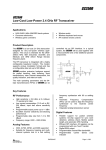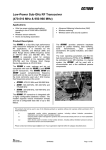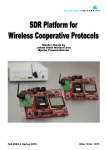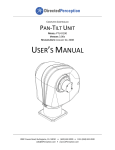Download Application Note 038
Transcript
Application Note 038 CC1100/CC2500 – Wake-on-Radio By E. Syvertsen, S. Namtvedt Keywords • CC1100 • CC2500 • Wake-on-Radio 1 • Ultra low-power • Implementation example Introduction The low cost, highly integrated multichannel CC1100/CC2500 RF transceiver offers Wake-on-Radio (WOR) functionality intended for ultra low-power wireless applications. By using this feature for automated low-power RX-polling the user obtains an attractive starting point for implementing power-saving applications for ultra low-power systems. CC1100/CC1150DK and CC2550DK respectively. CC2500/ The WOR examples are designed as primitive wireless remote control systems, whose intention is to provide an insight into important considerations when using the WOR functionality. It is demonstrating a packet bursting transmitter and a Wakeon-Radio receiver. This application note outlines code examples taking advantage of the Wakeon-Radio functionality featured by the CC1100/CC2500 chip, which are part of the SWRA055 Page 1 of 14 Application Note 038 Table of Contents KEYWORDS.............................................................................................................................. 1 1 INTRODUCTION............................................................................................................. 1 2 ABBREVIATIONS........................................................................................................... 2 3 WAKE-ON-RADIO (WOR).............................................................................................. 3 3.1 WOR PRICIPLES ........................................................................................................ 3 3.2 WOR AND CC1100/CC2500..................................................................................... 3 3.2.1 WOR without auto sync ....................................................................................................4 4 WOR EXAMPLES USING CC1100/CC2500.................................................................. 6 4.1 GENERAL DESCRIPTION OF EXAMPLES ......................................................................... 6 4.2 “WOR” EXAMPLE: SIMPLE PACKET BURST PROTOCOL EXAMPLE .................................... 7 4.2.1 Protocol description .........................................................................................................7 4.2.2 Timing calculations ..........................................................................................................8 4.3 “WOR-ACK” EXAMPLE: PACKET BURST PROTOCOL WITH ACK .................................... 10 4.3.1 Protocol description .......................................................................................................10 4.3.2 Timing calculations ........................................................................................................11 4.4 RUNNING THE EXAMPLES .......................................................................................... 12 5 GENERAL INFORMATION .......................................................................................... 13 5.1 DOCUMENT HISTORY................................................................................................ 13 5.2 DISCLAIMER ............................................................................................................. 13 5.3 TRADEMARKS .......................................................................................................... 13 5.4 LIFE SUPPORT POLICY ............................................................................................. 13 6 ADDRESS INFORMATION .......................................................................................... 14 2 Abbreviations ACK CRC EB EM FS GDO MCU RF RSSI RX SPI TX WOR XOSC Acknowledgment packet Cyclic Redundancy Check Evaluation Board Evaluation Module Frequency Synthesizer General Data Output Microcontroller Unit Radio Frequency Received Signal Strength Indicator Receive (mode) Serial Peripheral Interface Transmit (mode) Wake-on-Radio Crystal oscillator SWRA055 Page 2 of 14 Application Note 038 3 3.1 Wake-on-Radio (WOR) WOR priciples For many battery operated (point-to-point) communication systems without the need of constant throughput, but with strict demands of power-efficiency, the simple configuration with an “always-on” receiver and an infrequently transmitting station will in most cases not fulfill the desired power budget. By using the principle of receive mode (RX) polling, the reduction of the RX duty cycle obtained makes low-power applications feasible, especially in asymmetric systems where all units do not have equal requirements for low power consumption. In addition, to minimize the power consumption, it is a good idea to put the radio in a power-saving sleep state in between the RX polling periods by disabling all functionality that is not necessary at that time. The advantage with WOR is that the RX polling is fully automated by the radio and there is no need for the microcontroller (MCU) to interfere (strobe RX commands). This means that also the MCU can stay in power-down mode and further save power while waiting for a packet. The MCU will only have to wake up when the radio actually detects a packet – it only has to Wake-on-Radio activity. This is the reason WOR is a useful feature for power-saving applications. 3.2 WOR and CC1100/CC2500 The Wake-on-Radio functionality of CC1100/CC2500 enables it to stay in a power-saving SLEEP state and periodically wake up from deep sleep and listen for incoming packets in RX without microcontroller interaction. The programmable wake-up period is controlled by a WOR timer, run by an internal RC oscillator. This implies that the RC oscillator must be enabled before the WOR strobe command can be used. The radio’s configurable GDO pins are used to signal the interrupts intended for the MCU on the desired event. For instance, if a sync word is detected during the RX period, the CC1100/CC2500 can trigger an interrupt to wake up the MCU. The MCU can then make a decision on what to do next; e.g. switch to TX and send an ACK or, if the CRC of the received packet failed, continue in WOR mode (go back to SLEEP). In the latter case, after a packet has been received, the radio will always go to the IDLE state. That means that if it is desirable to continue in WOR mode, the MCU manually has to strobe another WOR command on the SPI. If no sync word is detected while in RX, a programmable RX timeout will make the chip automatically return to sleep mode and continue in WOR mode without interrupting the MCU. The Wake-on-Radio functionality may also be used in combination with CC1100/CC2500 ’s RX_TIME_RSSI function. This function will perform an initial RSSI level measurement when entering RX mode, and if the RSSI value does not exceed a programmable threshold, the RX will terminate immediately and return to SLEEP – still in WOR mode. This function can reduce the time in RX and contribute to lower power consumption if no signal is present. The CC1100 offers two different methods of using WOR – with or without the automatic synchronization feature, while CC2500 offers only WOR without autosync. This application note will only look at WOR applications not using autosync. SWRA055 Page 3 of 14 Application Note 038 3.2.1 WOR without auto sync The simplest way to utilize WOR is when a transmitter continuously “bursts” packets at a fixed interval. In this case, by configuring the receiver to wake up regularly to listen for a packet, it is not necessary to use the autosync feature. The frequency of the low-power RC oscillator controlling the WOR timer varies with temperature and voltage supply. To keep this frequency as accurate as possible, the RC oscillator is calibrated when the crystal oscillator (XOSC) is running and the radio is not in the SLEEP state. The clock used by the WOR timer is then a divided XOSC clock. When the radio enters the SLEEP state, the RC oscillator will use the last valid calibration result. The time when CC1100/CC2500 wakes up from the SLEEP state and the time when the radio is starting RX mode are denoted as EVENT0 and EVENT1 respectively. The course of events is shown in figure 1. The wake-up interval, shown as tEvent0 in figure 1, i.e. the time between two consecutive EVENT0s and also two consecutive EVENT1s, is configured with the WOREVT registers. tRx_time RX tRx_time SLEEP EVENT0 EVENT1 RX EVENT0 EVENT1 tEvent0 tEvent1 SLEEP t tEvent0 tEvent1 Figure 1: Wake-on-Radio procedure It is important to notice that the time between an EVENT0 and the following EVENT1 cannot be set too short. Provided that the XOSC is powered down while the radio is in SLEEP, there must be enough time for the XOSC to start after the wake-up. If automatic calibration of the frequency synthesizer when entering RX is enabled, tEvent1 must be set long enough to also finish the calibration of the frequency synthesizer before RX starts. The tEvent1 timer is configurable through the WORCTRL register. In order to ensure that a valid sync word is detected by the WOR receiver when using a packet bursting wake-up protocol, i.e. packets are repeatedly sent with a fixed time interval, it is important to set the timeout for sync word search in RX properly (denoted tRx_time in figure 1). The timeout must be greater than the interval between transmitted packets. If this criterion is not fulfilled, the receiver might, in worst case, end up polling in between sync words, missing out on all the packets. This subject will be further illustrated in the protocol description of the “WOR” example. An overview of the principal WOR related registers for the CC1100/CC2500 is found in table 1. SWRA055 Page 4 of 14 Application Note 038 Table 1: WOR related registers Register and field name Description IOCFG2.GDO2_CFG[5:0] GDO2, GDO1, and GDO0 output pins configuration respectively. At least one GDO signal should be used to provide Wake-onRadio interrupts to the MCU. IOCFG1.GDO1_CFG[5:0] IOCFG0.GDO0_CFG[5:0] PKTCTRL1.WOR_AUTOSYNC (CC1100 only) Automatically synchronize the WOR timer to the received packet in Wake-on-Radio mode. If enabled, the timer will automatically reset the WOR timer when a sync word is detected. The auto sync function is not discussed in this application note. MCSM2.RX_TIME[2:0] Timeout for sync word search in RX. The timeout is relative to the programmed EVENT0 timeout. For relation with tRx_time, see below. MCSM0.XOSC_FORCE_ON Force the XOSC to stay on in the SLEEP state. Normally not set with the intention of minimizing power consumption when in SLEEP, but may be used when reduced wake-up time is necessary. WOREVT1.EVENT0[15:8] High and low byte of the EVENT0 timeout register configuring the RX polling interval. See formula for tEvent0 below. WOREVT0.EVENT0[7:0] WORCTRL.RC_PD Powers down the RC oscillator. Must be set to 0 to enable the RC oscillator for WOR applications. WORCTRL.EVENT1[2:0] EVENT1 timeout. Configures the number of RC oscillator clock periods to wait after EVENT0 before EVENT1 should occur (see data sheet). Time for potential crystal stabilization and/or calibration of the frequency synthesizer must be considered if XOSC has been turned off while in SLEEP (MCSM0.XOSC_FORCE_ON) or auto calibration is enabled (MCSM0.FS_AUTOCAL). WORCTRL.WOR_RES[1:0] Controls the time resolution of EVENT0 and other WOR settings. See data sheet for possible resolutions. MCSM0.FS_AUTOCAL[1:0] Configures whether/when to perform automatic calibration of the frequency synthesizer between state transitions. MCSM1.RXOFF_MODE[1:0] Selects the next state after finishing packet reception. MCSM1.TXOFF_MODE[1:0] Selects the next state after finishing packet transmission. The relations between timeout values and register values for some of the registers in table 1 are given by the following expressions: RX polling interval: t Event 0 = 750 ⋅ EVENT 0 ⋅ 2 5⋅WOR _ RES f xosc (1) Sync word search timeout while in RX: t Rx _ time = t Event 0 2 ( RX _ TIME +3+WOR _ RES ) ⇒ 12.5% 2 ( RX _ TIME +WOR _ RES ) (duty cycle, WOR) SWRA055 , RX _ TIME < 7 (2) Page 5 of 14 Application Note 038 For MCSM2.RX_TIME = 7 = 1112, the radio will stay in RX until a packet has been received, i.e. no actual timeout. Please see the CC1100/CC2500 data sheet for descriptions of the other registers. 4 WOR examples using CC1100/CC2500 4.1 General description of examples The two WOR examples described in this application note can be considered as implementations of the same simple control system for a radio-controlled object. The system is modeled as a simplex system with a transmitting remote control sending packets with control commands to the remotely controlled receiving object. WOR is used to reduce power consumption at the receiver side. Since both examples are implementations of the same remote control system, they are very similar, but they are using different protocols. The first and most primitive example is implemented as a purely simplex system with no transmission error control. The transmitter is set to burst a fixed number of packets relying on one of them being detected by the WOR receiver. The second example can be considered as an improvement of the first one, because of its expansion to also include ACKs from the receiver to verify each received packet. Even if CC1100/CC2500 is a multi-channel RF transceiver, both examples utilize only a single channel. Please note that the examples are not supposed to be an ideal, complete example implementation of a remote control system. Their main purpose is to serve merely as a demonstration of how to use the WOR functionality of CC1100/CC2500. Because of this, some aspects are left out for better illustrating WOR. The example code is written for two SmartRF®04EB (Evaluation Boards) using the on-board Silicon Labs C8051F320 MCU together with CC1100/CC2500EM. One evaluation board (EB) is configured to be the remote control (TX unit), and the other as the remotely controlled object (RX/WOR unit). The joystick position on the remote control is displayed on the LCD of the remotely controlled EB. A system setup is modeled in figure 2. CC2500EM CC2500EM CC2500 CC2500 Remote control (TX unit) SPI SPI RF link MCU MCU Joystick LCD SmartRF ®04EB SmartRF ®04EB Remotely controlled object (RX/WOR unit) Figure 2: System setup for both examples showing CC2500 In order to achieve a low-latency remote control, the response time of the system must be sufficiently small. For this system, an RX polling interval (tEvent0) of 300 ms has been set as an SWRA055 Page 6 of 14 Application Note 038 upper bound on the response time when disregarding potential packet errors. To avoid unnecessarily long duty cycles, both examples operate with a rather small packet format. It is possible that the remote control only transmits commands describing the changes at the controls, e.g. the new state of the controller joystick, information not requiring more than one byte of data payload per packet. Thus the examples will use the 1-byte fixed length packet format shown in figure 3. Preamble Sync word 4 bytes 4 bytes Data payloa d 1 byte CRC 2 bytes Figure 3: Packet format in WOR example Preamble bytes and sync word will be added automatically by the CC1100/CC2500 when transmitting. When operating with a fixed payload length, in this case one byte, there is no need for a length byte. The optional one-byte address field is also excluded due to simplicity. The data byte contains the necessary joystick state information. The last two CRC bytes are appended automatically provided that CRC calculations are enabled. This means that only the single byte marked with blue is fetched from the TX FIFO buffer, and the rest is generated by the radio itself. For more details and possibilities regarding the packet format, see the CC1100/CC2500 data sheets. 4.2 “WOR” example: Simple packet burst protocol example 4.2.1 Protocol description The “WOR” example uses a simplex protocol scheme illustrated in figure 4. This simple protocol does not provide any form for ACK confirming a received packet, and packet traffic is therefore solely uni-directional. Because of its simplicity, and despite its unreliability, the protocol is a fitting example illustrating the main concepts of using WOR. Remote control: TX unit tPacket_burst (> tEvent0) tPacket_interval (< tRx_time) IDLE IDLE Joystick event Controlled object: RX/WOR unit RX RX RX Potential RX timeout Ev0 Ev1 tEvent0 = 300 ms Potential RX timeout SLEEP SLEEP SLEEP Ev0 Ev1 tRx_time = 1.17 ms t Detected packet Detected packet Joystick event Missed packet IDLE IDLE TX TX Ev0 Ev1 t Figure 4: Example protocol without ACK SWRA055 Page 7 of 14 Application Note 038 In this example, the receiver is configured to wake up and perform an RX poll searching for transmitted packets every 300 ms to obtain a suitably low response time. Upon any change of state of the remote control’s joystick, the transmitter initiates a burst by sending a fixed number of identical packets. To make sure the receiver has a chance to acquire one of the packets, the burst durability cannot be less than the time spacing between two subsequent RX periods (tPacket_burst > tEvent0). This will ensure that at least one RX poll period will occur during the wake-up burst period. It is also important that the receiver’s RX period lasts at least as long as the entire packet interval (tRx_time > tPacket_interval) to ensure that at least one incoming sync word will coincide with the receiver’s RX poll period. If this is not fulfilled the receiver might risk start listening right after a sync word has been transmitted and stop listening right before the subsequent sync word is sent and as a consequence miss out on the whole burst of packets. Please note that if the receiver is detecting a sync word right before the RX is timing out it will stay in RX until the end of the packet, potentially extending the duty cycle, like illustrated with the last RX poll in figure 4. By looking at figure 4 it may seem like the receiver goes back to the SLEEP state automatically after receiving a packet. This is not correct. When a packet has been received, the radio switches to the IDLE state. The MCU should have been programmed to receive an interrupt whenever the radio detects a valid sync word, and also take care of what to do next after the radio has been awoken from WOR mode. For this protocol example, the MCU checks the CRC status of the packet, parses the payload, and regardless of the result puts the CC1100/CC2500 back to SLEEP as soon as possible continuing the Wake-on-Radio mode in order to minimize the power consumption. 4.2.2 Timing calculations The transmitted packets within a wake-up packet burst should be uniformly spaced in time, something that can be achieved by using a programmable timer in the MCU to trigger off each packet. To reduce the remote control’s TX duty cycle and subsequently the power consumption, the CC1100/CC2500 enters the IDLE state in between each packet. Worth noting is that increasing the IDLE period of the transmitter by increasing the packet interval will reduce the TX duty cycle. But to still fulfill the need of having an RX polling period at least the size of the packet interval, the RX duty cycle has to increase correspondingly, increasing the RX duty cycle. These considerations have to be adjusted according to specifications of the application. As a system specification for this example, a limit of 0.5% RX duty cycle has been set at the receiver as maximum, while still minimizing the power consumption on the transmitter side to a certain degree. Firstly, the EVENT0 register value corresponding to a 300 ms RX poll interval must be calculated. For this relatively short time interval, setting WOR_RES = 0 gives a fitting resolution. By using equation (1) and assuming a 26.0 MHz crystal (used on CC1100/CC2500EM), EVENT0 can be determined: 300 ms = 750 ⋅ EVENT 0 ⋅ 2 5⋅0 26.0 MHz ⇒ EVENT 0 = 10400 = 28 A016 (3) This word is split into the two byte-sized registers WOREVT1 and WOREVT0, which constitute the high and low byte of the EVENT0 timeout register, i.e. WOREVT1=2816 and WOREVT0=A016. The transmitter is configured for operating at a bit rate of 250 kbps, which gives a necessary TX time of at least 352 µs to send the 88 bit long packet. To achieve less than 0.5 % RX duty cycle the timeout for the sync word search in RX has to be less than SWRA055 Page 8 of 14 Application Note 038 300 ms * 0.5 / 100 = 1.5 ms. These two values (352 us and 1.5 ms) represents the theoretical absolute minimum and maximum value for tRx_time. Having the WOR_RES decided to be 0 (equation (3)), an appropriate RX timeout within the duty cycle limit may be found by using the given equation (2): t Rx _ time (duty cycle) = 12.5 % 2 ( RX _ TIME + 0 ) < 0.5 % ⇒ RX _ TIME ≥ 5 (4) Choosing MCSM2.RX_TIME=5=1012 corresponds to an RX timeout of: t Rx _ time = 300 ms 2 (5+3+0) = 300 ms 256 = 1.172 ms ⇒ (5) 12.5 % = 0.391 % (duty cycle, WOR) 2 ( 5+ 0 ) With a known RX timeout period we are able to determine the TX packet interval. A packet interval of 1.0 ms would make a 0.172 ms difference with the RX timeout, and should constitute sufficient percentual margin for coping with possible oscillator frequency offsets due to temperature and voltage variations. With 1.0 ms packet interval, the transmitter in the “WOR” example transmits 305 packets for each wake-up burst, meaning tPacket_burst = 305 * 1.0 ms = 305 ms > tEvent0 = 300 ms. The extra margin is added because of possible oscillator and timer variations. The packet interval decides the TX duty cycle, in this case a TX duty cycle of (352 µs / 1000 µs) * 100% = 35.2%. Another important aspect is that the packet spacing, the time from the end of one packet to the start of the next one, has to be sufficiently large to account for the necessary time for state transitions between IDLE and TX and also possibly any frequency synthesizer (FS) calibrations. This means that in this example the CC1100/CC2500 will not have 1000 µs – 352 µs = 648 µs in IDLE for each packet sent – the delays between state transitions have to be subtracted. If we for this simple packet burst protocol assume it is only necessary with an initial manual FS calibration before the burst starts and there is no calibration prior to each packet within the burst, the IDLE to TX transition will take 88.4 µs and the conversely TX to IDLE takes 0.1 µs without calibrations. This leaves a theoretical time of 559.5 µs in IDLE state per packet sent. All these time values are assuming a 26.0 MHz crystal. An illustration of the packet burst timing is shown in figure 5. 559.5 µs 0.1 µs 352 µs 88.4 µs 559.5 µs 0.1 µs 352 µs 88.4 µs > 721 µs Figure 5: Timing for the simple packet burst example, showing start of burst On the Wake-on-Radio side, the receiver is recommended to enable automatic calibration of the frequency synthesizer whenever switching from IDLE to RX. Configuring the MCSM0.FS_AUTOCAL register bits equal to 012 does this. In most cases, including this example, the XOSC_FORCE_ON bit of the MCSM0 register is left unset, turning off the XOSC SWRA055 Page 9 of 14 Application Note 038 when entering SLEEP state during WOR mode to reduce the power consumption. When the radio wakes up to IDLE state at EVENT0, there must be enough time for the crystal to start up and stabilize (typically 300 µs) and for the calibration of the frequency synthesizer (typically 809 µs) before the RX can begin at EVENT1; in total a wait period of over 1.1 ms. This implies the WORCTRL.EVENT1 bits for this case must be set equal to 1112, configuring tEvent1 = 1.38 ms (with a 26.0 MHz crystal). 4.3 4.3.1 “WOR-ack” example: packet burst protocol with ACK Protocol description The “WOR-ack” example is using a similar protocol as the “WOR” example, but this has been extended by including support for acknowledge (ACK) of each received packet. Upon a joystick movement, the remote control EB starts bursting identical packets until it gets an ACK back from the receiving EB. This means that there, in contrast to the previous example, is no fixed number of packets in a burst. In order for the remote control to be able to detect the acknowledgement packets that will make it halt the packet burst, it has to switch to RX for a short period in between each packet. In addition the remotely controlled EB (still referred to as the receiver since the data traffic still is simplex) will now have to transmit an ACK in response of a received packet. The ACK is sent immediately after a valid packet has been received. If the receiver is awoken from the Wake-on-Radio mode by receiving an invalid packet (wrong packet length, containing CRC error etc.), no reply will be sent. The MCU will in either case make the receiver go back to WOR mode. Due to protocol changes, the WOR EB will be programmed to automatically switch to the FSTXON state when a packet has been received instead of to the default IDLE state (MCSM1.RXOFF_MODE = FSTXON). FSTXON is a state where the frequency synthesizer is left on, ready to start transmitting. The transmission starts very quickly after the STX command strobe has been issued. When the WOR EB has received a valid sync word and the MCU has been made aware of it, the MCU will check the CC1100/CC2500 ’s RX FIFO for content and check any packet’s validity. Meanwhile the receiving unit will be waiting in FSTXON state, prepared to rapidly transmit an ACK. If there is no need to send an ACK, the MCU will issue the SIDLE command strobe to go back to IDLE state, and then the SWOR strobe, continuing in WOR mode. Almost similarly, the transmitter will automatically switch to RX instead of IDLE at the end of each packet transmission (MCSM1.TXOFF_MODE = RX). This is necessary to listen for any ACKs, while at the same time being time saving compared to a manual SRX strobe. The receiver is ACKing the packets with a payload byte equal to the inverted command byte received. The remote control parses the ACK packet in order to verify that it is an ACK for the current joystick position. If it is an ACK that has been received, the ongoing packet burst is halted. If no ACK is detected, an RX timeout will put the transmitter back to IDLE. For the “WOR-ack” example it is also implemented an upper limit of packets to send without getting any ACK, functioning as a packet burst timeout preventing the transmitter to endlessly transmit without any purpose. In theory, the transmitter should never have to transmit more than 305 packets in a burst, as discussed in section 4.2.2. However, when running the application example, one will occasionally experience that more than 305 packets are transmitted before an ACK is received. There are two possible reasons for why this might be happening: 1. The receiver was in RX while the packet was transmitted, but something disturbed the signal so that the radio was not able to receive the packet properly. 2. The receiver did receive the packet and transmitted an ACK, but the transmitter did not receive the ACK. This again, can be due to two different things: • Same as #1 above SWRA055 Page 10 of 14 Application Note 038 • 4.3.2 The RX timeout on the transmitter was too short due to the RC Oscillator bug on CC2500. Please refer to CC2500 Errata Note 001. Timing calculations For the “WOR-ack” example some of the timing properties are kept equal to those used for the “WOR” example. At the receiver side the polling period of 300 ms and the RX duty cycle are preserved, still with an RX timeout of 1.172 ms. Accordingly, the transmitter still operates with a packet interval of 1.0 ms. The FS calibration routines are also maintained; the transmitter only performs a calibration at the start of each packet burst, and the receiver performs a calibration prior to every RX polling period. Whenever the receiver detects a packet, the transition from RX to FSTXON will take 9.6 µs. The transmitting CC1100/CC2500 will almost simultaneously execute the 21.5 µs lasting transition from TX to RX. After a small delay in software (RX FIFO must be checked for packet, data processing etc.), the MCU on the receiving EB will have decided whether to send an ACK or not. Refer to figure 7 for protocol timing details. This delay is expected to clearly exceed the difference in transition time of almost 12 µs. The RX timeout of the transmitter must therefore be set long enough to still wait in RX when the sync word of a potential ACK is sent. To transmit 4 bytes of preamble plus 4 bytes of sync word at 250 kbps takes 256 µs. Adding certain delay margins for propagation delay and processing time sets the RX timeout at the transmitter to 325 µs. A sketch of this can be found in figure 6. It would also have been possible to let the RX never time out, i.e. wait in RX for a packet until the 1.0 ms timer triggers off the next packet to be transmitted. This would of course have increased the duty cycle of the transmitter. 0.1 µs 325 µs 21.5 µs 352 µs 88.4 µs 213 µs 0.1 µs 325 µs 21.5 µs 352 µs 88.4 µs > 721 µs Figure 6: Remote control timing for the packet burst with ACK listening The introduction of ACK to this simple protocol causes an increase of duty cycle on both sides. In addition to the 35.2% TX duty cycle, the transmitter will experience an RX duty cycle of 325 µs / 1.0 ms * 100% = 32.5%. The price of ACKing is not as high for the receiver as for the transmitter; the CC1100/CC2500 with WOR will only have an extra TX duty cycle of 352 µs / 300 ms * 100% = 0.117% at maximum together with the already 0.391% RX duty cycle. SWRA055 Page 11 of 14 ACK Detected pkt Application Note 038 FSTXON 0.1 µs 352 µs 9.6 µs 1.17 ms Figure 7: Receiver timing for the Wake-on-Radio with ACK reply 4.4 Running the examples For a description of how to load the programs into your SmartRF®04EB, please refer to the publication “CC1100/CC2500 Examples Libraries User Manual” found on the Chipcon website, http://www.chipcon.com. Together with the .hex files, the source code with comments will be found. Before running the programs, EB units must be configured to either be the transmitter unit bursting packets or the receiver unit using Wake-on-Radio. This is done in the setup menu by moving the joystick sideways – move it left to choose TX unit and right for RX/WOR unit. Push the S1 button to confirm your choice. After the unit has been configured, the yellow LED will turn on. If the TX unit is selected, you are now able to push the joystick button or move it up, down, left or right. This will start the packet burst and the number of packets sent in the burst will be displayed on the LCD. For the “WOR” example, the number of packets in a burst is constant, but for the “WOR-ack” example the burst will continue until an ACK has been received or a timeout occurs. The blue LED will toggle for each packet sent. For the “WOR-ack” example the green LED will toggle every time a valid ACK has been received, and the red LED will toggle for non-valid packets received. If the RX unit is selected, it will automatically enter the Wake-on-Radio mode, waiting for packets. For the “WOR” example, every time a packet has been detected and the radio is sending an interrupt signal to the MCU, the blue LED will toggle. For the “WOR-ack” example the blue LED will only be toggled when it is transmitting an ACK. For both examples, a toggle of the green LED will indicate a packet has been received successfully, and the red LED will toggle whenever an invalid packet has been received. The LCD will continuously display how many valid packets have been received together with the position of the joystick on the remote control. Both programs can be terminated by pressing the S1 button after the setup has been done. This will turn off the yellow LED. SWRA055 Page 12 of 14 Application Note 038 5 5.1 General Information Document History Revision 1.0 5.2 Date 2005-11-22 Description/Changes Initial release. Disclaimer Chipcon AS believes the information contained herein is correct and accurate at the time of this printing. However, Chipcon AS reserves the right to make changes to this document without notice. Chipcon AS does not assume any responsibility for the use of the described product; neither does it convey any license under its patent rights, or the rights of others. The latest updates are available at the Chipcon website or by contacting Chipcon directly. As far as possible, major changes of product specifications and functionality, will be stated in product specific Errata Notes published at the Chipcon website. Customers are encouraged to sign up to the Chipcon Newsletter for the most recent updates on products and support tools. When a product is discontinued this will be done according to Chipcon’s procedure for obsolete products as described in Chipcon’s Quality Manual. This includes informing about last-time-buy options. The Quality Manual can be downloaded from Chipcon’s website. Compliance with regulations is dependent on complete system performance. It is the customer’s responsibility to ensure that the system complies with regulations. 5.3 Trademarks SmartRF® is a registered trademark of Chipcon AS. SmartRF® is Chipcon's RF technology platform with RF library cells, modules and design expertise. Based on SmartRF® technology Chipcon develops standard component RF circuits as well as full custom ASICs based on customer requirements and this technology. All other trademarks, registered trademarks and product names are the sole property of their respective owners. 5.4 Life Support Policy Chipcon’s products are not designed for use in life support appliances, devices, or other systems where malfunction can reasonably be expected to result in significant personal injury to the user, or as a critical component in any life support device or system whose failure to perform can be reasonably expected to cause the failure of the life support device or system, or to affect its safety or effectiveness. Chipcon AS customers using or selling these products for use in such applications do so at their own risk and agree to fully indemnify Chipcon AS for any damages resulting from any improper use or sale. © 2005, Chipcon AS. All rights reserved. SWRA055 Page 13 of 14 Application Note 038 6 Address Information Web site: E-mail: Technical Support Email: Technical Support Hotline: http://www.chipcon.com [email protected] [email protected] +47 22 95 85 45 Headquarters: Chipcon AS Gaustadalléen 21 N-0349 Oslo NORWAY Tel: +47 22 95 85 44 Fax: +47 22 95 85 46 E-mail: [email protected] US Offices: Chipcon Inc., Eastern US Sales Office 35 Pinehurst Avenue Nashua, New Hampshire, 03062 USA Tel: +1 603 888 1326 Fax: +1 603 888 4239 Email: [email protected] Chipcon Inc., Western US Sales Office 19925 Stevens Creek Blvd. Cupertino, CA 95014-2358 USA Tel: +1 408 973 7845 Fax: +1 408 973 7257 Email: [email protected] Figure 8 Wireless 10509 Vista Sorrento Parkway, Suite 420 San Diego, CA 92121 USA Tel: +1 858 522 8500 ext.6 Fax: +1 858 552 8501 Email: [email protected] Sales Office Germany: Sales Office Asia: Chipcon AS Riedberghof 3 D-74379 Ingersheim GERMANY Tel: +49 7142 9156815 Fax: +49 7142 9156818 Email: [email protected] Chipcon AS Unit 503, 5/F Silvercord Tower 2, 30 Canton Road Tsimshatsui, Hong Kong Tel: +852 3519 6226 Fax: +852 3519 6520 Email: [email protected] Sales Office Japan Chipcon AS #403, Bureau Shinagawa 4-1-6, Konan, Minato-Ku Tokyo, Zip 108-0075 Tel: +81 3 5783 1082 Fax: +81 3 5783 1083 Email: [email protected] Chipcon AS is an ISO 9001:2000 certified company © 2005, Chipcon AS. All rights reserved. SWRA055 Page 14 of 14

















![Hacking Medical Devices - [media.blackhat.com]](http://vs1.manualzilla.com/store/data/005931227_1-f7547ce2b3ff0825b843d9b1dbb48800-150x150.png)





